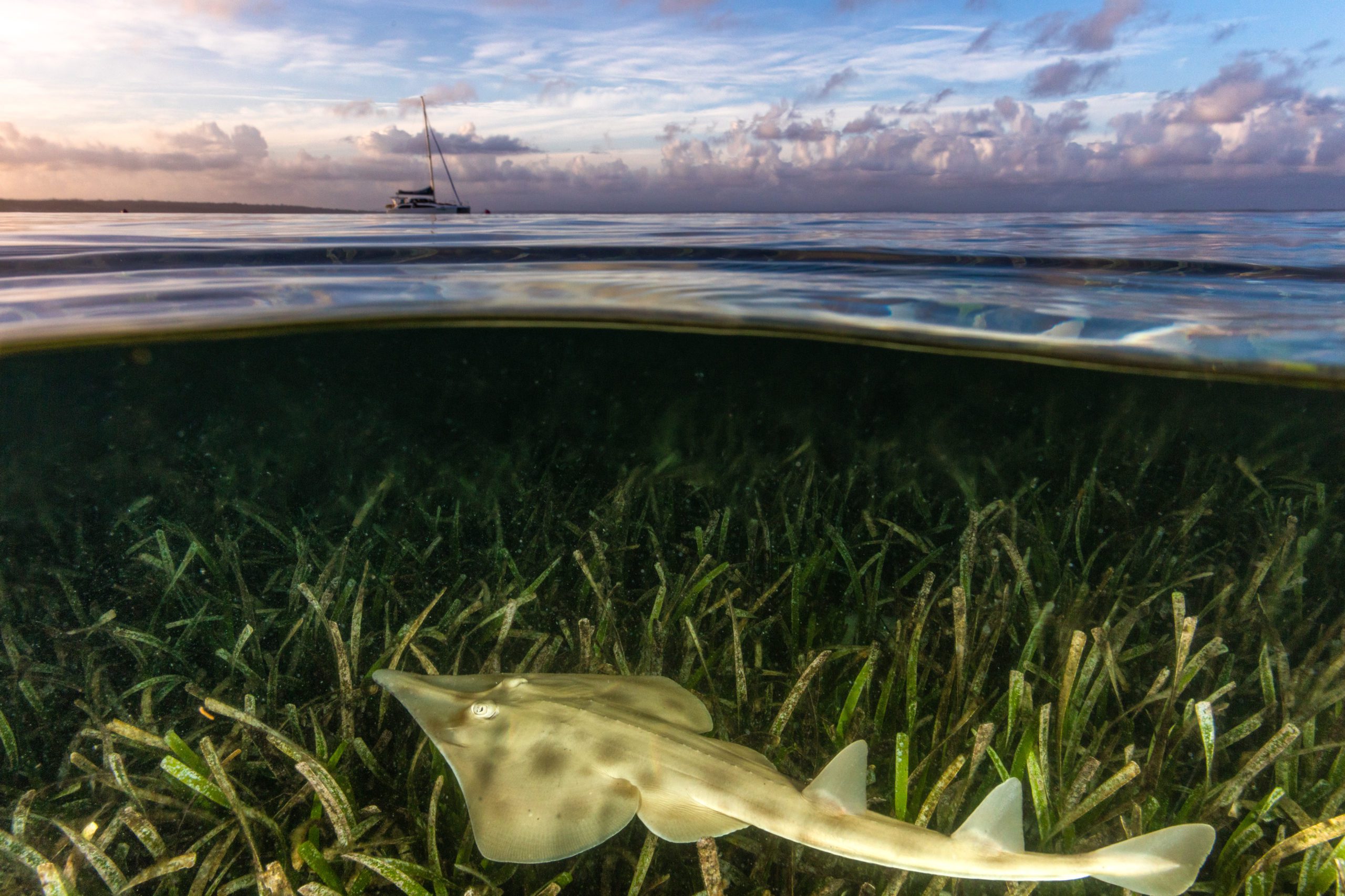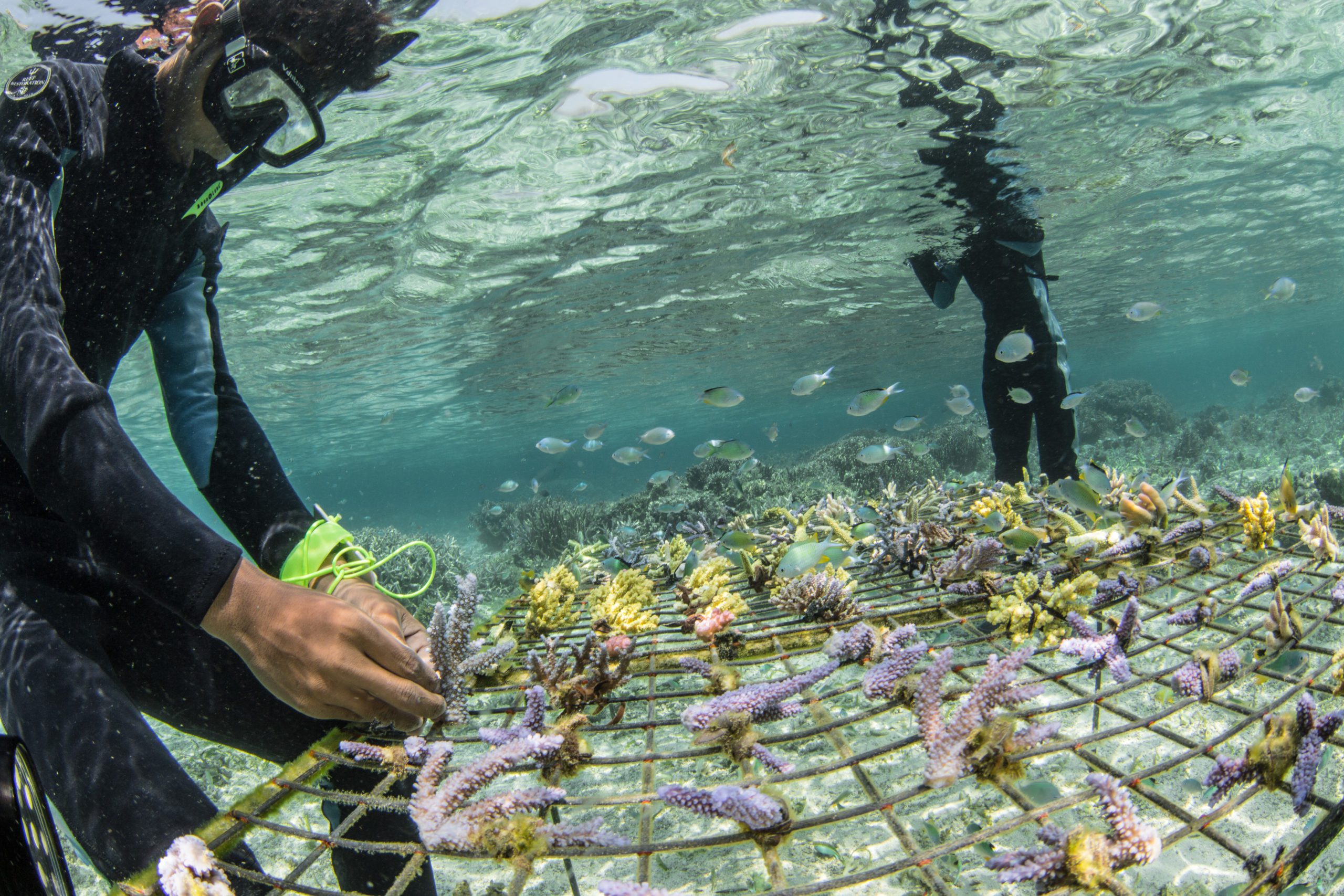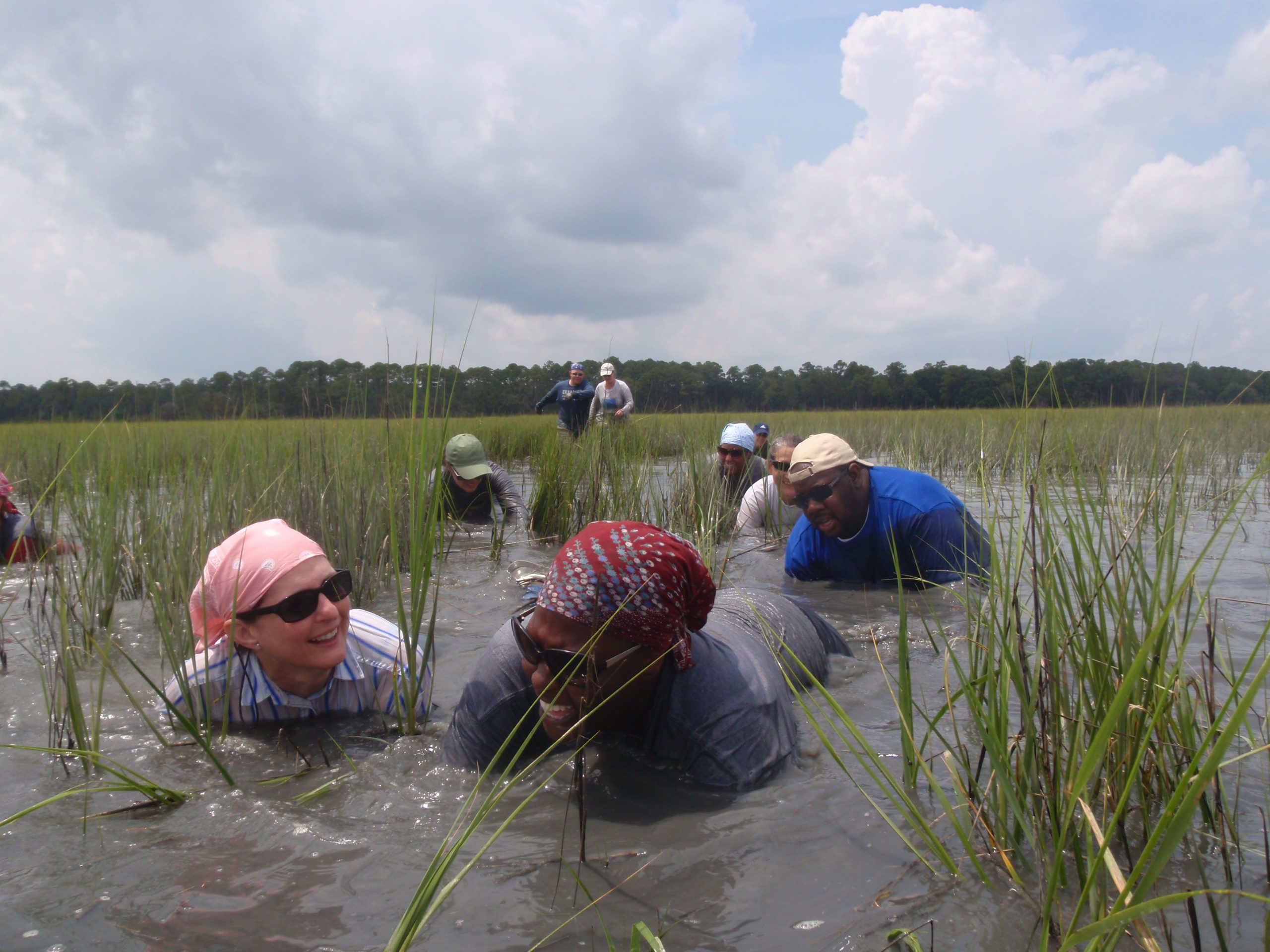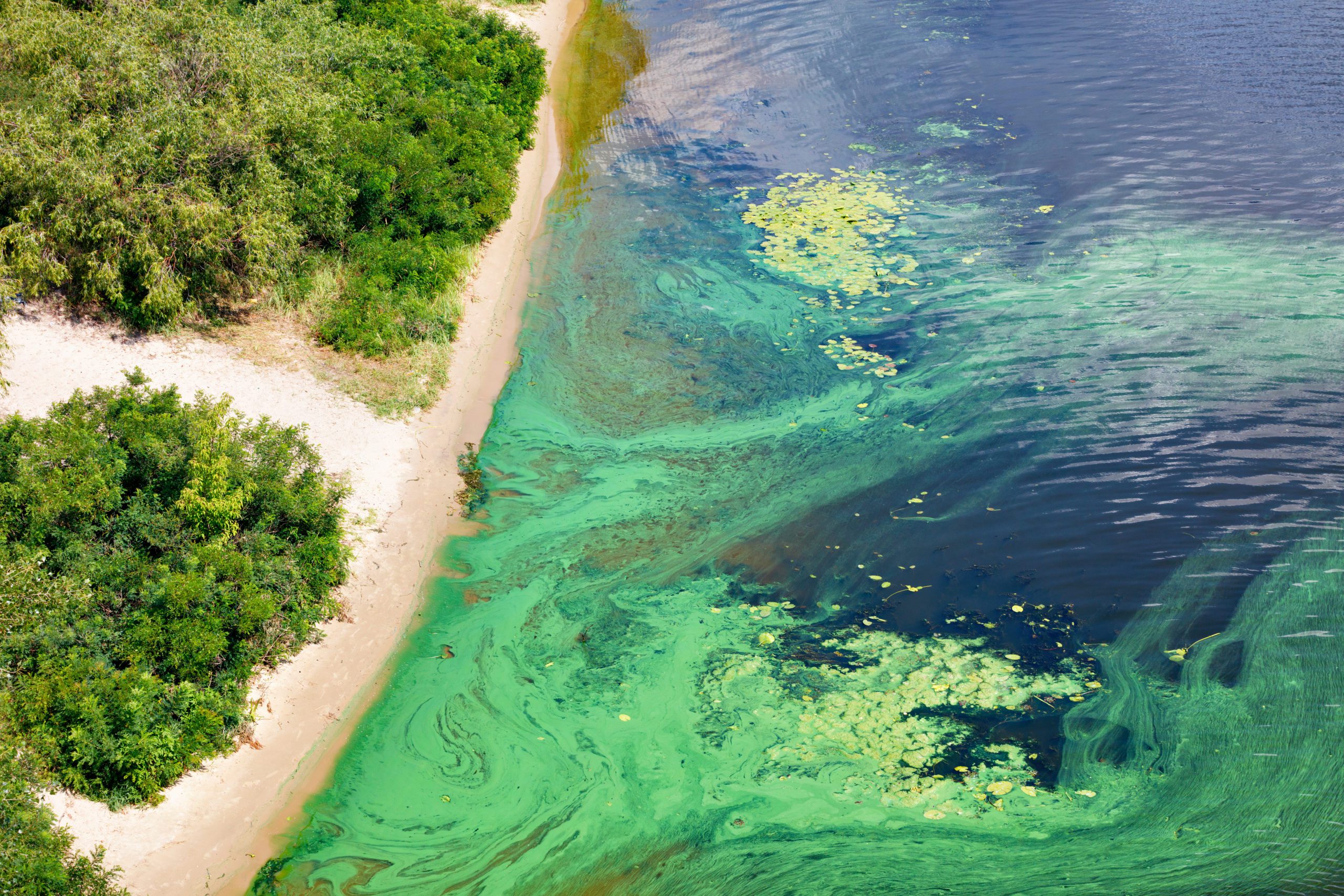Our Shared Seas spoke with Dr. Amelia Wenger—a research fellow at the University of Queensland and Associate Conservation Scientist for the Wildlife Conservation Society (WCS)—to learn more about how wastewater affects coastal ecosystem and human health, including coral reefs. In this interview, she explains why marine protected area management must consider land-based threats, as well as what is needed from researchers, funders, and practitioners to work across silos to implement solutions now.

Ray in seagrass. Photo: Jordan Robins / Ocean Image Bank
How does water quality affect marine ecosystems, and what role does wastewater play?
Water quality affects marine ecosystems in a variety of ways. Wastewater really is a cocktail in that it contains nutrients from human waste, freshwater, pathogens, and pharmaceuticals, among other components. Those components interact with the environment in a lot of different ways. A major one is by enriching coastal zones with excess nutrients, which can lead to eutrophication and low oxygen levels that suffocate organisms. Another is that the particulate matter in wastewater can block sunlight. A lot of marine organisms depend on light, including corals. When light gets reduced, it can affect those organisms’ ability to feed and grow properly. A lot of pathogens that we have in our systems can also affect marine systems. Pathogens from human waste can cause disease in corals. Then there are pharmaceuticals, which can impact marine organisms in so many ways we’re still trying to understand. Estrogen, for example, can affect sex ratios in organisms. We’re still trying to unpack how prevalent that is.
How are you seeing climate change interact with those impacts?
Wastewater and climate change impacts interact in ways that spell trouble for marine ecosystems. We have evidence that coral reefs in nutrient-enriched environments are more susceptible to bleaching. We’ve also seen that excess nutrients can increase the prevalence of organisms that burrow into corals, which weakens their structure and changes their calcification rates, which in turn increases their vulnerability to ocean acidification.
But even if we stopped climate change tomorrow, water quality would still be a problem for coastal and marine ecosystems, which is why we need to reduce the amount of pollution entering the marine environment.
But even if we stopped climate change tomorrow, water quality would still be a problem for coastal and marine ecosystems, which is why we need to reduce the amount of pollution entering the marine environment.
What has surprised you most about working on coastal water quality?
Even though most marine scientists and practitioners would say that water quality is an issue for marine ecosystems, there just hasn’t been as much emphasis on identifying solutions. We’ve historically focused some on the impacts of water quality but less on what to do about it. When I started doing my PhD, there was a lot of emphasis on marine protected areas, how they worked, and how to design connected marine reserves. We were still unpacking that science.
Now that we’ve had long-term monitoring of marine protected areas, people are starting to understand how much water quality does underpin and drive ecosystem degradation and impact ecosystem recovery. I’m starting to see increased awareness of that and a paradigm shift among marine scientists that we need to also focus on improving water quality because the marine protection we’re putting in place isn’t fully cutting it.
I’m still not seeing much emphasis on terrestrial ecosystem restoration in conversations about coral restoration, which I find surprising, given what we know about poor water quality and coral reef health. I think there’s a real opportunity for terrestrial restoration efforts and coral restoration efforts to combine forces. Improving water quality should be an important part of the conversation about coral and marine ecosystem restoration.
I think there’s a real opportunity for terrestrial restoration efforts and coral restoration efforts to combine forces. Improving water quality should be an important part of the conversation about coral and marine ecosystem restoration.

Coral restoration in Indonesia, Coral Guardian. Photo: Martin Colognoli / Ocean Image Bank
What can the marine conservation community gain from addressing wastewater pollution?
These threats don’t occur in a vacuum. You have to manage systems holistically. If we really want to see improvements in marine ecosystems, we have to address all of the threats that are driving ecosystem degradation.
Wastewater affects the ecosystem services that we get from marine ecosystems, like fisheries and coastal protection, through ecosystem degradation. There are also very real public health concerns associated with pollution from wastewater. We spend millions of dollars a year on the health care costs associated with people swimming in polluted water or eating contaminated seafood. We can improve public health outcomes too by addressing wastewater.

Sanctuary education programs work with teachers, students and communities across the nation to make the connection between America’s waterways and our ocean treasures. Here, educators from the Atlanta metro area literally follow Georgia’s rivers and streams that lead to Gray’s Reef National Marine Sanctuary as part of the annual “Rivers to Reefs” workshop. Photo Credit: Gail Krueger / NOAA
What do you think the biggest barriers are to improving coastal water quality? And how are they being addressed, if at all?
There are a couple of barriers I want to highlight here: funding and siloed programs. I want to start by saying that there are some really great examples of marine ecosystem recovery when we have reduced the amount of coastal pollution through upgrades to wastewater treatment. The large seagrass recovery in Tampa Bay, Florida, is a great example. In the late 1970s the state legislature passed a law requiring local wastewater treatment plants to improve their treatment and remove more nutrients from treatment plant effluent. In a few years, they had reduced nutrients by 90 percent and eventually saw full seagrass recovery. This and other case studies of marine ecosystem recovery following wastewater pollution reduction demonstrate that ecosystems can rebound when given the chance.
There are lots of cities around the world that require upgrades to sewer systems or wastewater treatment to meet both human health and ocean health standards that will require investment in infrastructure. For instance, even though New York City has advanced wastewater treatment facilities, the majority of the sewer system is a combined sewer overflow system, which was first introduced in the 1800s. This means that during heavy rainfall events, raw sewage and stormwater combine and are released via outfalls into the surrounding waters. The city is now addressing the problem, but you can imagine that upgrading underground infrastructure around New York City is a very expensive endeavor. One way to motivate that investment is to increase awareness of wastewater as an important economic resource.
Sanitation planning in general is complex—be it the upgrading of extensive infrastructure, ensuring safe management and disposal of generated waste, or implementing new sanitation activities in places for the first time. So many components need consideration and investment to even achieve sanitation goals that it’s not super-surprising that ocean health is not at the top of the list. If we are serious about wanting ocean-friendly wastewater management, then marine conservation stakeholders need to be part of the sanitation planning process from day one in order to identify opportunities to tailor plans to also achieve ocean health goals. There is increasing awareness of the need to work across sectors and there are groups dedicated to creating enabling conditions to do just that, such as the Ocean Sewage Alliance.

Coastal algal bloom. Photo: iStock
For all the research we have left to do to understand this issue, do you think we know enough to act now?
If we are serious about protecting marine ecosystems, coastal pollution is a threat that we have to address. We know that wastewater affects ecosystems, which is enough to tell us we should be working on this. We know enough to know that when you mitigate this threat, you see important ecosystem changes.
There are some questions we haven’t fully answered, like by how much do we need to improve water quality before we start seeing ecosystem change? I think we need to just start improving wastewater and we’ll measure, monitor, learn, and adapt. We know that where we are is not great. Let’s just start moving the needle and we can be incremental in our approach.
If we are serious about protecting marine ecosystems, coastal pollution is a threat that we have to address. We know that wastewater affects ecosystems, which is enough to tell us we should be working on this. We know enough to know that when you mitigate this threat, you see important ecosystem changes.
Are there examples of particularly effective solutions for improving water quality you’ve come across in your work?
You can see impressive system change just from improving wastewater management to primary treatment from no treatment or from primary to secondary treatment. Marine ecosystems respond well when we stop dumping waste on them. Obviously, we want to move toward a system where we’re not dumping any effluent or we’re dumping only very well-treated effluent into marine ecosystems, but even modest improvements can improve ecosystem health.
How can marine funders engage on coastal water quality issues?
Wastewater pollution is a human and ecosystem health problem. We know from past experiences that improving wastewater management can help with human and ecosystem health. Funders are in a unique position because they can interact with other funders in ways that practitioners might not be able to. If I were a marine conservation funder wanting to engage on this issue, I would reach out to my network to find out who is funding projects in the sanitation space in places where I am investing. I think it would be very cool to see funders from the public health, sanitation, and conservation sectors build a consortium to fund wastewater management projects that could achieve public health goals and ecosystem health goals. There’s a real opportunity to tick lots of Sustainable Development Goal boxes this way. There needs to be engagement among practitioners from the different sectors for these projects to take root, but having funding bodies recognize the importance of cross-sector collaboration is an important step in the right direction.
There needs to be engagement among practitioners from the different sectors for these projects to take root, but having funding bodies recognize the importance of cross-sector collaboration is an important step in the right direction.
